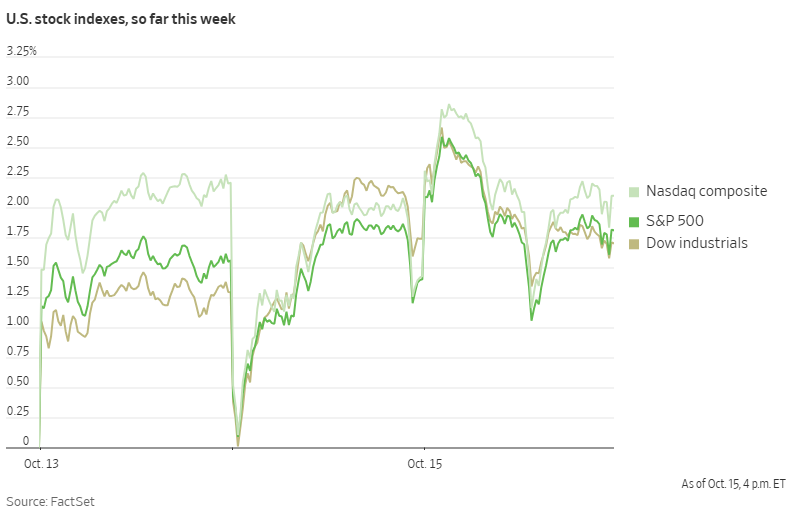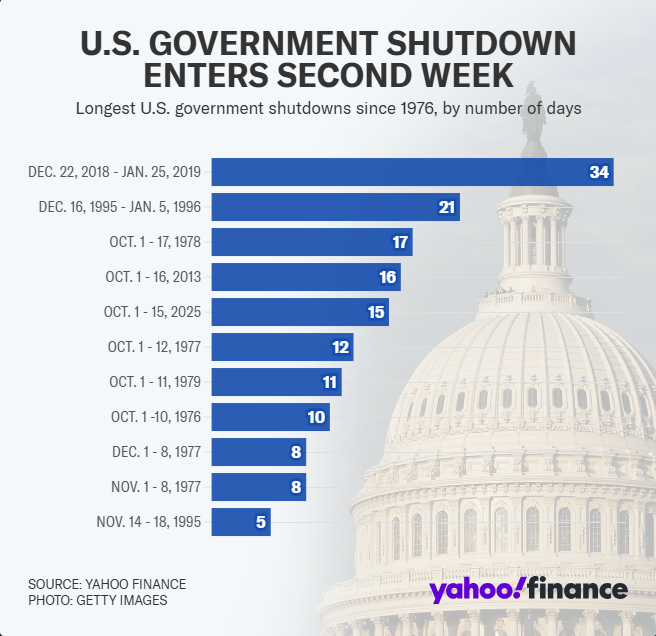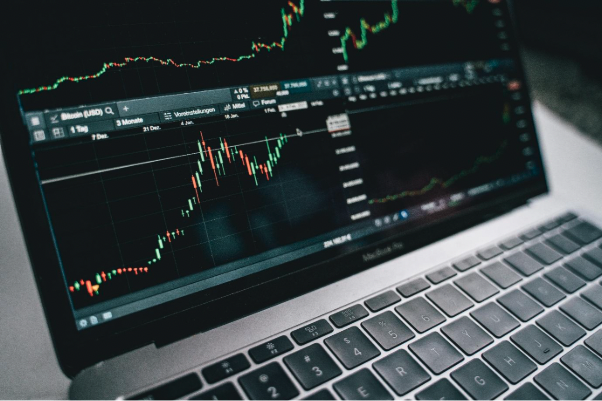市场资讯及洞察

S&P 500 and ASX Rally as Big Banks Drive Markets
Both the S&P 500 and ASX have rallied on the back of stronger-than-expected major bank earnings reports on both sides of the Pacific.
In the US, Bank of America reported a 31% year-over-year increase in earnings per share at $1.06, exceeding Wall Street's estimate of $0.95. Meanwhile, Morgan Stanley delivered a record-breaking quarter with EPS of $2.80, a nearly 49% increase from the same period last year.

On the Australian front, the benchmark ASX 200 leapt 1.03% to 8990.99, with all four major Australian banks playing a major role. CBA closed 1.45% higher, Westpac 1.98%, NAB 1.87%, and ANZ 0.53%.
These strong bank results indicate broader economic strength, despite recent concerns about US-China trade tensions. US Treasury Secretary Scott Bessent emphasised that Washington did not want to escalate trade conflict with China and noted that President Trump is ready to meet Chinese President Xi Jinping in South Korea later this month.
With the third-quarter earnings season just getting underway, these early positive results from financial institutions could prove as the start of continued market strength through to the end of the year.
U.S. Government Shutdown Likely to Last Into November
Washington remains gridlocked as the U.S. enters its 16th day of shutdown. With no signs of compromise on the horizon, it appears increasingly likely the shutdown will extend into November and could even compromise the Thanksgiving holiday season.
Treasury Secretary Scott Bessent has warned "we are starting to cut into muscle here" and estimated "the shutdown may start costing the US economy up to $15 billion a day."
The core issue driving the shutdown is healthcare policy, specifically the expiring Affordable Care Act subsidies. Democrats are demanding these subsidies be extended, while Republicans argue this issue can be addressed separately from government funding.
The Trump administration has taken steps to blunt some of the shutdown's immediate impact, including reallocating funds to pay active-duty soldiers this week and infusing $300 million into food aid programs.
However, House Speaker Mike Johnson has emphasised these are merely "temporary fixes" that likely cannot be repeated at the end of October when the next round of military paychecks is scheduled.

By the end of this week, this shutdown will become the third-longest in U.S. history. If it continues into November 4th, it will surpass the 34-day shutdown of 2018-2019 to become the longest government shutdown ever recorded.
This prolonged shutdown adds another layer of volatility to markets. While previous shutdowns have typically had limited long-term market impacts, the unprecedented length and timing of this closure, combined with its expanding economic toll, warrant closer attention as we move toward November.
Trump Announces Modi Has Agreed to Stop Buying Russian Oil
Yesterday, Trump announced that Indian Prime Minister Narendra Modi has agreed to stop purchasing Russian oil. He stated that Modi assured him India would halt Russian oil imports "within a short period of time," describing it as "a big step" in efforts to isolate Moscow economically.
The announcement comes after months of trade tensions between the US and India. In August, Trump imposed 50% tariffs on Indian exports to the US, doubling previous rates and specifically citing India's Russian oil purchases as a driving factor.

India has been one of Russia's top oil customers alongside China in recent years. Both countries have taken advantage of discounted Russian oil prices since the start of the Ukraine invasion.
Analysis suggests India saved between $2.5 billion to $12.6 billion since 2022 by purchasing discounted Russian crude compared to other sources, helping support its growing economy of 1.4 billion people.
Trump suggested that India's move would help accelerate the end of the Ukraine war, stating: "If India doesn't buy oil, it makes it much easier." He also mentioned his intention to convince China to follow suit: "Now I've got to get China to do the same thing."
The Indian embassy in Washington has not yet confirmed Modi's commitment. Markets will be closely watching for official statements from India and monitoring oil trading patterns in the coming weeks to assess the potential impact on global energy flows and prices.
Chart of the Day - Gold futures CFD (XAUUSD)


IntroductionAs any experienced trader has seen in the reality of the market, knowing when and how to exit trades is arguably as important, if not more important, than knowing when to enter. We have invested a lot of time on Inner circle webinars discussing exit approaches not only in terms of management of potential capital risk i.e. the potential to lose on a trade, but equally as impactful on overall outcomes the approaches you can implement in reducing the amount of “giveback” when in a trade that goes in your desired direction i.e. profit risk.One such approach is to use an incremental method, rather than closing an entire position at once, to lock in profit through the use of a partial close. This, in simple terms, allows a trader to close a portion of their trade, so banking some profit, while keeping the rest open.As with any approach in your trading decision making, and in the quest for consistency in action so you can see what works and doesn’t in your trading system, this should be planned and of course executed with consistency, as through this, discipline you will be able to find the approaches that are a best fit for you and your trading style and objectives.Unfortunately, although many may have dabbled with the concept of partial close, often this is not backed up with that required consistency, rather occurring as a ‘heat of the moment’ ad-hoc decision that may not serve you well for a lifetime of trading.This article aims to help you develop this part of your trading plan exit strategy, defining what partial closes are, how to make them happen with consistency to enable informed system refinement, and the options you can explore for managing the remaining position.What Is a Partial Close?A partial close is a profit risk management approach where a trader exits only a portion of their position prior to a final ultimate profit target being hit. For example, if a trader enters a trade with 1.0 lots, should the trade moves in the desired direction, they might choose to close 0.5 lots once the trade reaches a predefined profit level, allowing the other 0.5 lots to continue running.This technique is commonly used across all trading styles and timeframes and can also be actioned manually or coded within an automated trading system, e.g. with an EA.Advantages of Using Partial Closes
- Lock in Profits: By securing some profit early, traders can realise some of the gains in a position, both the psychological pressure of holding the full position, reducing overall market exposure, as well as locking in some “banked” profit into their trading account.
- Reduce Risk: In practical terms, lowering exposure in a position (and so also the account market exposure) means that if the market reverses, the trader has less monetary risk. In addition to the percentage movement towards a take profit, partial closes can also be used to reduce risk in situations where market risk may be increased, such as prior to economic data release, while still preserving some upside potential if the data comes in favourably compared to what was expected.
- Increase Flexibility: Partial closes can be combined with other exit strategies, including trailing stops or time-based exits, allowing a strategic approach to profit risk management.
- Better Emotional Control: Traders may find it easier to stay disciplined with the remainder of the positions if they know part of their profits are already ”safe”.
Limitations and Challenges
- Capped Upside Potential: Exiting a portion early can reduce overall returns if the trade continues strongly in your favour.
- Complexity: Managing multiple exit points adds layers of decision-making, especially in discretionary trading. This reinforces the advantage of having written “when and how” guidelines for taking action as a formal part of your trading system.
- Trader Knowledge Limitations: Of course, there will be specific ways in which to action partial close on your trading platform. This does require some knowledge on the part of the trader to make sure these are actioned as planned. Methods to do this will differ from one platform type to another, so no assumptions can be made that just because you have done this on a different type of platform that it will be obvious on another. Of course, this can be learned easily through practice on a demo account before implementation on a live account.
Key Components of a Partial Close StrategyThere are three components to any partial close strategy, namely, when to act, how much to close, and your approach to managing the remaining portion of the trade that is still in the market. Let’s consider each of these.
- Timing: When to Perform your Partial Close
There are four common methods used:
- Target-Based: Close part of the trade at a specific reward-to-risk milestone, such as 1R (where R is the initial risk). In this case, it would not be uncommon to have multiple partial closures. e.g. at 1R, 2R etc.
- Technical Level: Exit a portion at known support/resistance or Pivot level to lock in profit at a potential pause or reversal point.
- Progress towards take profit: As referenced earlier, as one of the most common approaches, a preset take profit provides an opportunity to implement a partial close at a percentage move towards your take profit. E.g. you action this at 50% towards your take profit.
- Time-Based: Although less common, set time rules may be the action point. Often, closing part of the position after a certain number of candles or hours may be considered, or as previously referenced, a risk management approach when significant data release is imminent, e.g., CPI, jobs data
- Sizing Adjustment: How Much to Close
There are three potential approaches to this.
- Fixed Size: A predetermined percentage (e.g., 50%) of the position when the specified price target is hit. This is probably the most common and easiest to implement
- Scaled Reduction: Slightly more involved is the approach to gradually close smaller chunks of your position, such as 25%, then another 25% at later levels. The practicalities of this are more difficult to implement, not only in working out what the multiple closes may be in terms of overall position, but also could be difficult to implement with some strategies where a relatively small move is the overall target. In other words, the larger the distance between entry and final expected reversal or pause point, the easier this will be to act on.
- Dynamic Approach: For advanced traders, the option of basing the size of the partial close on trade conditions like volatility or market structure could be considered. In practice, this may take a considerable amount of time and a critical mass of results data to action consistently and may require multiple refinements to achieve such and demonstrate better outcomes than other approaches. For this reason, this is not common.
- Managing the Remainder of the Trade
Once a partial close has been executed, the remaining position still requires management.Options for management include:
- Leave the Stop Loss Unchanged: Allow the remaining portion to play out as per the original plan, maintaining your original full stop-loss distance. The advantage of this is that you still give the market a chance to move rather than the remainder being taken out by “noise”. Those who advocate this method would suggest that it can potentially create a no-lose situation where your partial close has covered your stop, BUT this values your net worth in a position at the entry price, NOT the value after a move in your favour.
- Structure-Based Trail: Move the stop behind recent swing highs/lows, so on each retracement on a move in your direction, you continue to lock in some more profit with the remainder of the trade.
- Move to Breakeven or Beyond: To eliminate the risk of the remaining portion and to improve the potential outcome that the best your partial close does in that described in the first scenario would be to move the stop to the entry price or above (e.g., breakeven +1 ATR) once part of the trade is closed.
Combining With Other Exit MethodsPartial closures do not exist in isolation. They can work alongside other experts such as”
- Fixed Take Profits: Set targets for final exit.
- Time-Based Exits: Exit the remainder if the trade stagnates.
- Trail Stop methods: Exit on reversal candlestick patterns or other dynamic trailing stops e,g, Price vs Moving average
The key is to ensure all components, including those associated with your partial close, are part of a consistently executed and tested strategy.Final Thoughts and SummaryPartial closes offer traders a way to blend some security with the opportunity of locking in gains while keeping the door open for a continued move in your desired direction.They can be particularly effective in volatile environments where prices can swing rapidly between technical zones and in the management of pre-data release situations.Without wanting to labour the point too much as with any trading method you use during the life of a single or multiple trades, the key is having a plan articulated that facilitates consistency, discipline in execution, and evidence-based decision-making following thorough testing of not only this approach but in comparing it against other “what-if” scenarios.We trust that as a minimum, this has given you food for thought it not only whether partial closes could be a fit for your trading but also some guidance about how to action this if you choose to follow through on an evaluation of this exit approach.


In the words of Bjork’ 90s indie hit “Oh So Quiet” –It's, oh, so quiet Shhhh, Shhhh, It's, oh, so still Shhhh, Shhhh, You're all alone Shhh, Shhh And so peaceful until…Until… that is the question, and considering it is ‘peaceful’, it's probably best to review the minutes from the Fed as it is signalling that the quiet time is not far from ending soon.FOMC: The Pressure BuildsThe May 6th to 7th Federal Open Market Committee (FOMC) minutes reaffirmed the Fed’s cautious stance, with Chair Powell keeping to the “wait and see” script. But under the surface, the outlook has become more complicated as event risk is getting louder.Clearly, Trump’s Tariffs have created new complications for the Fed’s dual mandate.As the minutes note:“With uncertainty higher due to ‘larger and broader’ than expected tariffs, the Committee may ultimately face a more difficult trade-off between its price stability and full employment mandates.”And this was well before the Trade Court’s decision that the Liberation Day tariffs are illegal under the Economic Emergency Act of 1977, and then it was subsequently overturned 24 hours later by the appeals court.The Fed has flagged increased downside risk to real activity and now sees the probability of recession as nearly equal to its baseline forecast. At the same time, inflation risks for 2025 have been revised upward, though longer-term projections remain skewed to the upside, particularly as inflation expectations creep higher.Seen in these quotes from the minutes:“The staff continued to view the risks around the inflation forecast as skewed to the upside, with recent increases in some measures of inflation expectations raising the possibility that inflation would prove to be more persistent than the baseline projection assumed.”“Many participants reported that firms planned to partially or fully pass on tariff-related cost increases.”To paraphrase Milton Friedman, “Tariffs are not a tax on the sovereign, they are a tax on the consumer.” And this is what is being missed by government officials and the President himself.A counterargument to higher cost is that Fed officials suggested there is a chance of weakening demand, lower immigration driven housing inflation, and competitive pricing tactics. Which would feed back into the risk of recession as mentioned above, and signal that the US is entering a new stagflation era.Seen here:“Several argued that there might be less inflationary pressure for reasons such as reductions of tariff increases from ongoing trade negotiations, less tolerance for price increases by households, a weakening of the economy, reduced housing inflation pressures from lower immigration, or a desire by some firms to increase market share rather than raise prices.”On employment, the labour market remains tight but is potentially vulnerable to hiring pauses as policy and trade risks weigh.“The labour market was seen as ‘broadly in balance’ and the unemployment rate as ‘low.’”“Participants were concerned that tariff uncertainty could lead to a pause in hiring and the labour market to soften in the coming months.”Financial market signals were mixed. Several participants noted an unusual pattern: long-term Treasury yields rose even as the dollar weakened and equities sold off, raising concerns about shifting correlations and safe-haven perceptions.“Some participants commented on a change from the typical pattern... with longer-term Treasury yields rising and the dollar depreciating despite the decline in the prices of equities and other risky assets... [noting] that a durable shift... could have long-lasting implications for the economy.”Monetary framework discussions continue as well. The Fed appears to be reconsidering its post-COVID commitment to flexible average inflation targeting (FAIT). The minutes state:“Participants indicated that they thought it would be appropriate to reconsider the average inflation-targeting language in the Statement on Longer-Run Goals and Monetary Policy Strategy.”An interesting development is putting more rigidity into the mandate currently, suggesting the Fed is looking to ‘safeguard’ policy changes from external political forces.Where does this leave the US and the Fed in the short term? Don’t expect any near-term policy change, but the longer the Fed delays, the steeper the eventual rate cuts may need to be as the risks of a tariff-induced recession lead to the monetary brake being released.The consensus is that by January 2026, a possible 125 basis point will come out of the Federal funds rate, some even are forecasting 175 due to the need to stimulate the economy rather than restrict it. The consensus figure would see the Federal Funds rate landing on the terminal rate of 3.00% to 3.25%, the unknown is when, the size and velocity of reaching this point will be.It is oh so quiet, but it won’t be for long if the Fed is anything to go by.


六月美债即将到期,国际贸易法院裁定特朗普征税越权,马斯克离职DOGE5月29日,美国国际贸易法院作出重大裁决,认定前总统特朗普依据《国际紧急经济权力法》(IEEPA)实施的全球性关税行为,缺乏法律依据,构成越权。受此影响,美股三大股指走高,黄金价格走弱,市场高度关注事件后续发展。一、发生了什么?美国国际贸易法院三位法官联合裁定,叫停特朗普此前依据IEEPA征收的所谓“解放日”关税,并宣布这一行为越权无效。具体而言:法院裁定特朗普无权基于IEEPA向他国加征关税,即总统不能将该法用于施加贸易惩罚。被叫停的关税包括:今年4月2日生效的“解放日”关税,以及此前对中国、墨西哥和加拿大施加、以打击芬太尼流入为名的进口关税。法院认为,这些关税违反了IEEPA的立法初衷,因为IEEPA从未被用于设立对外贸易壁垒,而主要针对资产冻结、金融制裁等紧急经济行为。需要注意的是,该裁决并不影响目前根据《贸易扩展法》第232条征收的汽车、钢铝制品等25%关税。二、事件的法律与政治背景关税征收权原属于国会,但自1974年《贸易法》修订后逐步赋予总统更大权限。特朗普任内频繁以国家安全、公共卫生等理由施加关税,开启了贸易政策“总统化”的先例。然而,IEEPA从未被用于常规征税,法院本次裁决为贸易权力的合法边界划出红线。三、后续可能发展目前白宫尚未回应该裁决。根据法律程序,特朗普团队可以向联邦巡回上诉法院或直接上诉至最高法院。尽管保守派在最高法院占据6:3多数,但历史表明其判决并非全然站队保守政治人物。这意味着,美国的贸易政策合法性审查很可能会成为2024大选年后又一次“国运之争”。四、市场影响初显近期美股处于震荡整理阶段,此次裁决如同“催化剂”,市场解读为减缓贸易紧张局势的利好:美股三大股指上扬,尤其是科技与消费类板块;黄金价格走弱,反映避险需求下降;投资者风险偏好回升,短期对全球市场情绪构成正面影响。五、马斯克“退出政坛”:政府效率改革告一段落另一重磅新闻是,埃隆·马斯克正式宣布退出特朗普政府的“政府效率部”(DOGE)工作,将专注回归特斯拉及个人商业帝国。马斯克任内主导削减联邦支出,原计划削减1万亿美元,实际仅节省约1600亿美元;其政策触动众多既得利益者,受到民主党和媒体的激烈批评,也影响其企业管理时间,导致特斯拉一度信心受损。可以说,马斯克的“政务试验”虽初衷为改革,却在现实利益中寸步难行。六、“大美丽法案”与美债困局特朗普政府推行的“大美丽法案”可能加剧当前财政负担:该法案包括大规模减税、削减福利、增加军费,短期内刺激经济,但长期扩大赤字;即便关税等手段带来部分财政收入,但很快就被高额支出吞噬,财政压力持续上升。七、债务悬崖在六月爆发可能性虽然美国政府将在6月初迎来大额国债到期,但大多数分析人士认为违约概率依然极低,原因包括:提高债务上限仍可作为手段;发行稳定币的监管框架逐渐明朗,要求其资产支撑为美债或现金,有望增强国债流动性;通过降息或债务再融资降低偿债压力;最终底牌是:美元的铸币权仍在美联储,若无其他办法,美方可选择容忍通胀,通过印钞应对。虽然长期美债问题确实存在系统性风险,但今年6月违约的可能性极低。总结美国国际贸易法院对特朗普全球征税行为的叫停,标志着总统贸易权力再次受到司法审查。市场短期利好,美股提振。与此同时,马斯克“卸甲归田”,专注商业回归,给特斯拉带来利好。尽管美债风险仍在,但在众多缓解手段下,6月危机暂时无虞。真正值得关注的是——长期财政赤字与美元信用的系统性考验,远未结束。联系方式:墨尔本 03 8658 0603悉尼 02 9188 0418中国地区(中文) 400 120 8537中国地区(英文) +248 4 671 903作者:Mill Li | GO Markets 墨尔本中文部


IntroductionAs many of you will know, Bitcoin, Ethereum, and an increasingly wide range of other cryptocurrencies have become one of the most closely followed asset classes globally by investors and traders alike. This, combined with the ability to trade these assets using CFDs, has simply added not only to their popularity but also provided you, as a trader, the potential to add something new on top of what you already trade.Its rise to a multi-trillion-dollar asset class has captured the attention of traders, investors, institutions, and even governments, as evidenced by daily updates within mainstream financial media.Crypto's appeal lies not just in its potential for speculative gains, but in its revolutionary structure, which means you are potentially trading a decentralised and borderless asset that operates outside traditional finance. Whether seen as digital gold, an inflation hedge, a future payment system, or simply a volatile trading opportunity, Bitcoin and its peers continue to attract attention.As stated before, more than ever, traders can access Bitcoin and other cryptos easily through a variety of instruments, including crypto CFDs. These allow participation without needing to open dedicated wallets or directly handle tokens, particularly convenient for those already using MetaTrader platforms (MT4/5), where Bitcoin CFDs and other crypto products are increasingly available. GO Markets is leading the way, adding to its crypto offering and as with an asset class, we aim to provide not only the products themselves but also some assistance to those looking at these either for the first time or to expand their exposure into some of the lesser-known cryptocurrency CFDs.As with any new instrument, there are essential things you must know, such as what moves the market, how the product is priced and traded, and how to manage the unique risks that crypto trading brings.On a point of definition, it is worth referencing the term “Altcoin”. This simply comes from combining "alternative" and "coin", and essentially groups together a broad and diverse group of cryptocurrencies with varying functions, technologies, and market purposes.So, whether you're just getting started or reassessing how you trade Bitcoin and crypto, this article aims to provide practical tips, insights into trading system development, and helpful resources to approach crypto markets with more clarity and control.Cryptos versus Crypto ETFs, or Crypto CFDs – Why Trade CFDs?So now onto market issues that may mean CFDs could be for you.Extended Trading Hours: The crypto market on the GO Market MT5 platform is open 24/7, unlike traditional markets, there's no downtime. Trading crypto CFDs lets you access this round-the-clock action without needing to hold the actual coins or use crypto exchanges. Importantly, with CFDs, your trading platform can be your single point of access for not only what instruments you trade already, but you can add crypto CFDs to your toolbox as easily as trading an FX pair or Share CFD.Direct Exposure to Price Action: Unlike ETFs or crypto-themed stocks, which are influenced by broader market factors or business performance, crypto CFDs allow you to trade the price of the asset directly. You’re trading exposure to Bitcoin or Ethereum itself, not a blockchain company's management effectiveness or an ETF's structure.Short and Long with Ease: Crypto CFDs allow you to go long or short easily. For traders looking to take advantage of changes in trader sentiment in EITHER DIRECTION, this is a major advantage of CFDs.Lower Capital Requirements: CFDs offer fractional trading, so you don’t need to buy a full Bitcoin (or even a whole altcoin token). You can start small, even at a 0.1 lot size and scale your position as your strategy begins to show positive outcomes and confidence grows. Your leverage and margin requirement will be dependent on account type, and it is worth emphasising that, as with any margin trading, the risks are exaggerated as well as the opportunity. As with any trading, capital protection and appropriate trade position sizing must remain at the forefront of any trading approach.What Moves the Price of Cryptos?As with gold, which we covered in a recent article, understanding what drives crypto prices helps you trade proactively rather than reactively, with the ability to perhaps see the potential for risks and opportunities early so you can be ready if a set-up or time to exit may be imminent.Before going into the major factors that move cryptos, it is worth briefly looking at the relationship between Bitcoin and altcoins generally, i.e. does a movement in Bitcoin necessarily mean a move in Altcoins?As a rule, most altcoins are positively correlated with Bitcoin (BTC), meaning when BTC goes up, altcoins tend to go up too, and vice versa.There may be a delay in altcoin movement, with BTC leading the way, especially in sharp market moves, although such moves may differ in relative % terms, particularly in lower-cost Altcoins.Additionally, it is worth referencing the potential for changes in specific Altcoins should there be regulatory or protocol-specific news (e.g., an SEC intervention or reports of hacking, for example).It is worth pointing out that some research should be undertaken on individual coin types prior to trading (as arguably you should ALWAYS do with any asset that is new to you).The key factors are as follows:
- Macroeconomic Sentiment: Bitcoin has increasingly behaved as a “risk-on” asset. It tends to rise when confidence returns to markets and fall during macroeconomic fear or liquidity stress. In good economic times, when perhaps investors have more available liquid cash and are happier to speculate, this could be a good time for cryptos. Also, in certain conditions such as increased inflationary concerns, Bitcoin as like gold, may be seen as a potential hedge. These narratives can shift quickly, but being in tune with financial news as well as what you are seeing on a chart may give clues as to how the market is viewing cryptos at any time.
- Regulatory Headlines: As referenced above, Bitcoin and altcoins are highly sensitive to regulation. News from the SEC, European Commission, or Asian regulators can trigger massive market moves as the perception of risk changes. A single statement from a central bank, policymakers or rulings on ETF approval (As we saw with recent increases in crypto ETF offerings) can spark short-term volatility.
- Institutional Adoption and Rejection: Any announcements of crypto being added or removed from payment platforms, ETF funds, or treasury holdings by major companies such as Tesla, BlackRock, or PayPal can sharply influence price in the short term.
- Network Activity and On-Chain Data: Particularly for altcoins, rising transaction volumes, developer activity, and user adoption can signal health and long-term viability. These metrics are often used by crypto-native traders to assess potential.
- Government Sentiment and Narrative: Clearly, and as seen since the inauguration of the recent US change in Government, any change in policy or inferences that regulation may be changed be whether tightened or relaxed, is likely to impact investor sentiment.
5 Practical Steps to Ease into Crypto CFD Trading
- Start with a Demo Account: Just like with gold CFDs, crypto's volatility is real and fast. Use a demo account to observe how Bitcoin or Ethereum behaves during major market sessions and how CFD pricing reflects this.
- Start Small on Live Trades: Begin with minimum lot sizes. Crypto price moves can be significant even on small trades. Slippage, spread widening, and gaps (especially over weekends or during system upgrades) are not uncommon.
- Understand Crypto-Specific Risk: Unlike gold, cryptos are (albeit rarely) vulnerable to hacks, chain outages, and delisting. While less relevant for CFDs, sharp price action can still result from these risks.
- Watch the Clock Differently: Crypto doesn’t sleep, but some hours are more active than others. Overlaps of US and European sessions, as with many asset classes, tend to see higher volumes. Major moves will often happen around US economic data as overall risk-on, risk-off sentiment shifts.
- Evaluate Altcoins Cautiously: If trading lesser-known coins, you need to be aware that these are often more volatile and news-driven. Lower liquidity and more retail speculative exposure can contribute to this, which can, of course, work both positively and negatively on price. Mitigate for this in your trading plan and intra-trade management.
Strategy and Risk Management ConsiderationsDefine Your Strategy: Are you trend-trading based on technical levels or swing-trading based on macro narrative shifts? Crypto, of course, may suit, but trading consistency ALWAYS requires clear entry and exit criteria as well as discipline in the execution of your plan.Adjust for Volatility: Use tools like ATR to set more realistic stops and targets. Bitcoin, for example, can EASILY move 3–5% in a standard day even without a major headline. Your system needs to reflect this.Incorporate Trailing Stops: Once in profit, use volatility-based trailing stops to protect from profit risk. i.e. giving too much back to the market with a successful trade.Use Breakout Confirmation: Altcoins, especially, are prone to false breakouts—often pumped and dumped quickly. Use volume, RSI/MACD divergence, or candle confirmation before acting.Avoid These Common MistakesOverleveraging: The temptation to “bet big” on a small move is real. But the reality of a 10% intraday swing should be enough to convince any trader to manage size carefully, as of course, risks are magnified with leveraged trading as stated previouslyChasing Hype Coins: Many traders lose by buying at the peak of any ‘hype cycle’. If you see price trending for some time or just hit a MASSIVE gain, you could be too late to the party. Have a plan to manage this potential risk.Ignoring Broader Markets: Bitcoin does not exist in a vacuum. Its correlation with Nasdaq, yields, and USD strength is growing. Don't ignore these intermarket relationships.Trading Every Coin You See: Focus on 1–3 cryptos, learn what they are, what specifically moves them and anticipated usual price action. Once you have mastered these them perhaps add one at a time. Random entries based on “this coin might go to the moon”. This is not a strategy, it is a gamble.Summary and Final ThoughtsCrypto CFDs offer exciting opportunities, but they also demand discipline, structure, and adaptability to manage risk effectively. The lessons from other markets still apply, including knowing what moves your market, having an unambiguous plan, and building confidence slowly as you execute both entry and exits.Whether you're trading Bitcoin or branching into altcoins, the goal isn’t just fast profits, but consistent, well-managed decisions over time with consistency in action so you can see what is working and what perhaps isn’t. As with all trading, performance evaluation is critical; only through effectively doing this can you refine what you are doing to move towards the crypto trade you can become.


引言:被低估的澳元与其资产属性近期澳元兑人民币(AUD/CNY)的表现引发市场关注。在利差压制和避险情绪主导下,澳元阶段性走弱,市场观点趋于谨慎。但从资产定价视角出发,我们认为澳元当前估值偏低,其商品属性、贸易结构和宏观政策环境依然稳健,有望逐步体现其内在价值。本文将从估值、出口商品、贸易账户、利差变化、美元周期以及市场情绪六大维度出发,探讨澳元兑人民币未来的可能表现路径。一、估值视角:历史低位中的相对修复潜力澳元目前处于近几年低位,2025年初一度兑美元跌至0.6184,换算为兑人民币亦下探至¥4.35左右,较2021年高点回落约15%。多个估值模型显示澳元被明显低估:RBC、德意志银行等研究指出其兑美元估值偏离约13%-20%。与此同时,澳元实际有效汇率(REER)也接近疫情后低点。这意味着,从历史均值与购买力视角来看,澳元存在一定的价值回归动能,市场预期的修正亦在酝酿之中。二、商品属性:出口商品韧性为澳元提供内在支撑作为典型“商品货币”,澳元对大宗商品价格变化高度敏感。当前铁矿石、煤炭、黄金等澳大利亚出口主力商品价格虽较前高位有所回落,但整体仍处于较强区间,澳大利亚的贸易条件指数保持相对稳定。据澳大利亚统计局,2024年四季度商品和服务贸易条件指数环比上升1.7%,反映出澳洲出口商品价格在国际市场仍具竞争力。此外,中澳经贸往来持续改善,中国继续作为澳大利亚最主要的贸易伙伴,为澳洲出口市场提供了广阔空间。三、宏观经济:低谷中企稳,政策框架稳定澳大利亚经济自2024年经历低增长后,已有初步企稳迹象。2025年初GDP环比增长回升至0.6%,就业市场稳定,通胀亦逐步回落至澳联储目标区间。2025年澳联储适度下调现金利率至3.85%,属于常规政策调整,在全球货币政策环境中仍保持较高的稳定性和透明度。对比而言,中国当前经济处于政策调节阶段,央行采取了更具流动性支持的策略,人民币利率中枢相对温和。值得说明的是,人民币汇率长期受到包括资本项目调控、经济基本面与全球因素共同影响,在稳定性与政策可控性上具有显著优势。本文更多从澳元端的资产修复逻辑展开分析。四、利差结构与美元周期:阶段性变化正在发生过去两年,澳美利差扩大构成澳元压力来源之一。但进入2025年,美联储与澳联储利率预期出现“收敛”迹象,甚至短期内可能形成轻度利差倒挂。在此背景下,澳元对美元、对其他货币的相对吸引力有望逐步修复。对人民币而言,澳元当前在名义与实际利差方面仍具有一定优势,部分国际资金出于组合多样化考虑,可能对澳元资产保持关注。同时,美元指数自2024年高位略有回落,若未来全球风险偏好提升、美元周期进入温和阶段,可能进一步为非美货币表现释放空间。五、市场情绪与仓位结构:一旦修复可能超预期CFTC数据显示,截至2025年5月中旬,澳元期货空仓仍维持在相对高位。当前市场预期较为单一,若后续出现宏观数据或政策超预期修复,存在情绪逆转并引发技术性反弹的可能。澳元作为风险偏好代表货币,历史上在“温和增长+通胀可控”的阶段往往有较好表现。随着全球宏观环境的改善,澳元可能成为市场重新布局的高贝塔资产之一。六、展望与结语:价值修复驱动AUD/CNY中期回归综上,从估值修复、出口结构、政策对比、利差趋势、仓位情绪等多重因素来看,AUD/CNY当前所处区间反映出汇率低估现象。若宏观与政策预期逐步兑现,未来澳元兑人民币存在温和反弹的空间。尽管全球仍面临贸易政策与经济周期的不确定性,但澳元作为商品货币与中等发达经济体代表,其资产属性值得投资者持续观察。风险提示:本文仅基于公开数据与市场信息分析,不构成任何投资建议或外汇交易建议。外汇市场波动受多种内外部因素影响,投资者需结合自身风险承受能力谨慎判断。联系方式:墨尔本 03 8658 0603悉尼 02 9188 0418中国地区(中文) 400 120 8537中国地区(英文) +248 4 671 903作者:Kara Yang | GO Markets 悉尼中文部


在交易的世界里,“自动化”这三个字越来越频繁地出现在我们的视野中。曾经只有机构才能用到的量化交易技术,如今普通交易者也能通过MT5(MetaTrader 5)轻松接触。

而对于刚入门的你,可能会遇到一个常见的选择题:我该用MT5平台自带的EA(专家顾问)系统,还是用Python来自定义交易逻辑?这个问题没有绝对的标准答案,更多的是看你的背景、兴趣和未来的发展方向。如果你正站在这条路的起点,这篇文章将帮你理清思路,找到最适合你的入门方式。一、EAMT5平台自带的EA(Expert Advisor)是一种基于MQL5语言编写的自动交易程序,能够根据设定好的逻辑自动进行买卖操作。它适用于技术分析交易者,可以设定指标信号、止损止盈、资金管理等规则。MT5还提供EA向导和策略测试器,帮助新手快速生成、优化和验证策略。新手可以通过官网上的代码库、说明文档和活跃的社区入门学习,助力交易策略搭建。

EA最大优势之一就是与MT5生态系统的高度兼容性。EA可以无缝对接平台上的各类工具和资源,包括技术指标、图表、市场深度、订单管理系统等,这使得用户能够构建起一个功能完备、流程清晰的自动交易系统。无论你想使用简单的移动平均交叉,还是复杂的多因子模型,EA都能支持。其扩展性和灵活性,使得构建一个涵盖信号生成、风险管理、资金分配和交易执行的完整系统变得可行。第二个显著优点在于它背后的编程语言——MQL5 是专为交易而设计的语言。相比于通用语言,MQL5内置了大量交易相关的函数、指标调用和图表控制工具,使得策略开发变得高效而精准。尤其值得一提的是其策略回测功能非常强大,支持基于真实点差和市场执行的多线程历史数据测试。这让交易者可以在实盘前清楚地评估策略的表现,降低试错成本。第三,MQL5语言在语法结构上与C++非常相似。这对有C++基础的用户来说是一个巨大优势——可以快速入门上手编写EA,实现自己的交易思路。综上所述,MT5平台自带的EA功能强大,借助MQL5专业的交易编程语言架构,为交易者提供了构建高效、专业自动化策略的完整工具链。二、Python作为一门通用编程语言,Python在金融领域的应用远远不止于下单执行,它为策略开发带来了前所未有的扩展性和灵活性。

首先,Python的强大之处在于它的功能不仅仅局限于交易本身。与MQL5主要服务于交易执行不同,Python拥有庞大的科学计算生态系统,支持大数据分析、机器学习、神经网络建模等。这意味着,交易者可以在策略开发中引入更复杂的逻辑,比如使用Pandas处理时间序列数据、用Scikit-learn进行因子分析,或借助TensorFlow和PyTorch实现深度学习模型,从而显著提升策略的智能化水平。其次,Python具有良好的跨平台能力。在MT5中,Python可以通过官方提供的MetaTrader5模块与平台交互,实现行情读取、下单、持仓管理等操作。同时,Python代码可以轻松迁移到其他量化平台,也可以对接交易所API或数据库。这种灵活性远胜于MQL5,后者只能在MT5平台内运行,限制了策略的可移植性和长期扩展空间。第三,Python语言本身更易于上手,相比于结构更严谨的MQL5,其语法简洁直观。使得即便是初学者,也能在短时间内实现较为简单的自动化交易策略。此外,Python社区活跃、文档丰富,学习资源随手可得,非常适合边做边学。总的来说,Python赋予交易者更强的数据处理能力、更大的平台自由度以及更简单的开发体验。对于那些希望将交易策略与智能算法相结合,或是希望将交易系统不断扩展升级的用户来说,Python无疑是一种值得深入学习和长期投入的强大工具。三、总结随着对Python和MQL5各自优势的了解,我们不难看出,两者适用于不同的交易者需求和发展路径。对于想进入MT5自动化交易的新手来说,Python和MQL5各有千秋,关键在于你的起点和目标。如果你是完全的新手,对编程和交易语言都还不熟悉,建议从Python入手。它语法简单、功能强大,不仅能帮你快速实现基础策略,还能为后续的数据分析、机器学习等高级应用打下坚实基础。而如果你已经在MQL5领域深耕多年,熟悉其语法和平台机制,那么继续精进MQL5,利用其与MT5的深度集成和强大的回测系统,依然是非常有竞争力的选择。不论你选择哪一条路径,关键是不断实践和学习。自动化交易是一场长期的修行,找到适合自己的工具,才是走得更远的第一步。免责声明:GO Markets 分析师或外部发言人提供的信息基于其独立分析或个人经验。所表达的观点或交易风格仅代表其个人;并不代表 GO Markets 的观点或立场。联系方式:墨尔本 03 8658 0603悉尼 02 9188 0418中国地区(中文) 400 120 8537中国地区(英文) +248 4 671 903作者:Michael Miao | GO Markets 悉尼中文部

